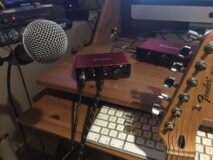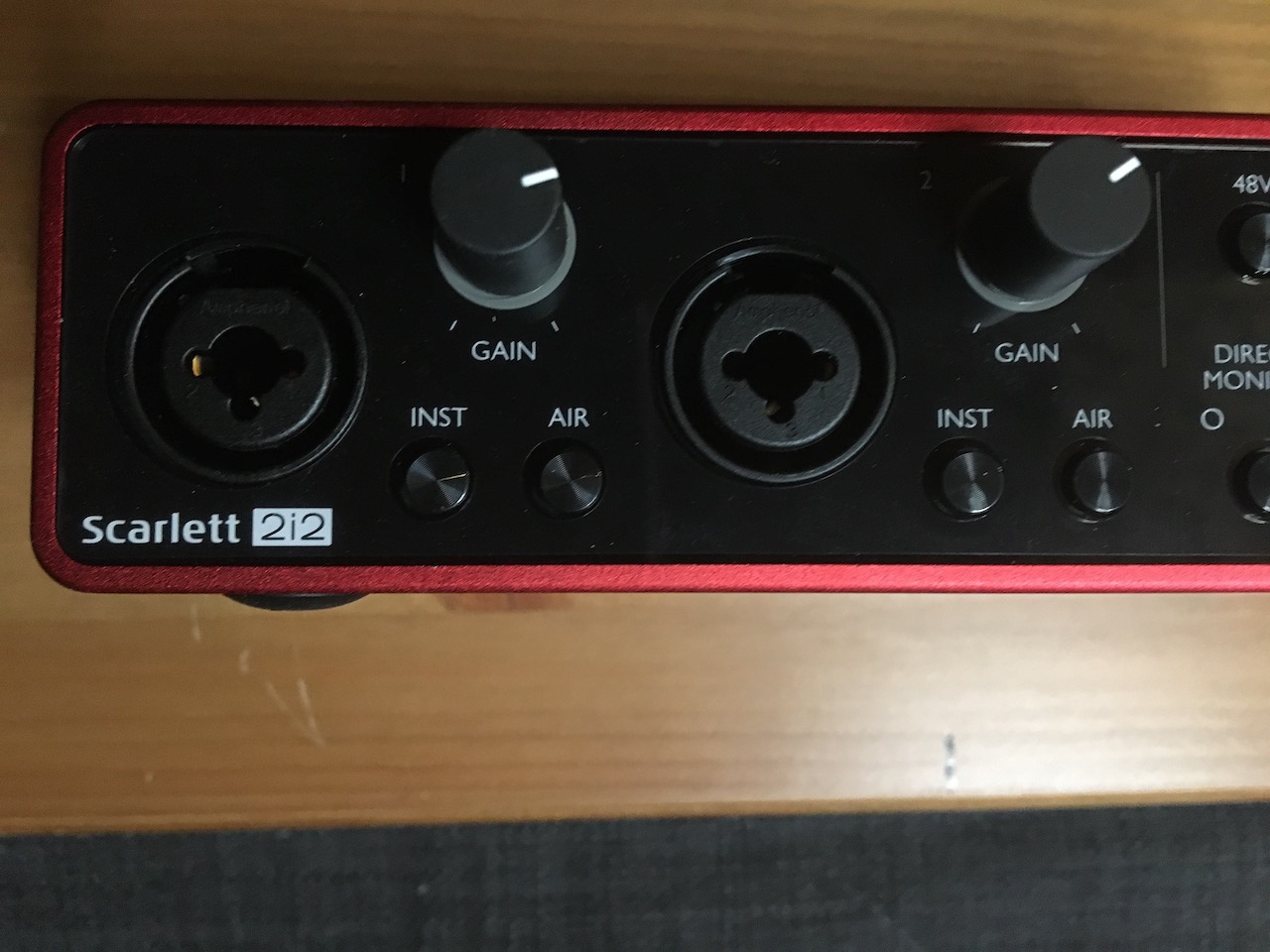
Today I review Focusrite’s Scarlett SOLO and Scarlett 2i2 3rd-generation audio interfaces. The Scarlett series are very popular audio interfaces for beginners and professionals alike, and with good reason. The third-generation Scarlett SOLO and Scarlett 2i2 offer some nice new features, and improved quality as well. As a Focusrite user myself, it’s fun to check out the new features and give you my opinion on the units. So, when Best Buy sent me these for review, I had to jump at the opportunity.
The SOLO and 2i2 audio interfaces share many similarities. I’ll tell you about their shared features first. You’ll find some differences explained further down in this article.
Scarlett SOLO and 2i2 are for beginners, singer-songwriters and podcasters
Their size and ease of use makes the Scarlett series a perfect audio interface for both beginners and experienced users. These two interfaces are very compact! The SOLO is about the size of a smartphone, albeit thicker overall. The size makes these a great choice for singer-songwriters or podcasters who are on the move. Setup is insanely easy. I connected to my DAW within 60 seconds and was immediately impressed. They sound great!

The units are aesthetically gorgeous too. Right out of the box, these Focusrite audio interfaces invoke creativity, functionality, confidence and value. Let’s not judge a book entirely by its cover, however. In my opinion, it what’s inside each unit that gives a huge boost to the quality of your project.
Focusrite has made high-quality recording studio equipment for nearly 40 years. They are lauded for their microphone preamps, which offer amazing quality of sound. Each of these Scarlett interfaces has two preamps for you to use, and you’ll be very happy with these (even if you’re new to understanding what a preamp does)!
So, why are preamps important?
A preamp “greets” your sound when you plug into the input of your DAW. Focusrite preamps are famous in the recording industry for providing a very solid foundation for building your sonic creations. Focusrite preamps provide a great foundation for your project.
Focusrite interfaces have a wonderful layout
Having an interface that’s painless and uncomplicated to operate is a huge plus. In my opinion, it’s one of the main improvements Focusrite offers compared to their older models of audio interfaces (such as their much older SAFFIRE series).
On the right side of the front panel is the “MONITOR” control, which is for your studio monitors. To it’s right you’ll find a headphone output as well. Bear in mind that this is a 1/4-inch headphone output, very standard for using studio headphones such as Audio-Technica, Sennheiser, and other popular brands. However, if you prefer headphones or earbuds with a smaller connection, (such as a 3.5mm), you’ll need the appropriate adapter. The Scarlett series does not support any wireless monitoring options, such as AirPods or other bluetooth listening devices.
Moving toward the left are the preamps and instrument inputs. Each have an adjustable gain, so you can dial in the right amount of the volume from the preamp.
Back panel simplicity
The back panel of the Scarlett series is very straightforward. You’ll find Left/Right Outputs for your speakers, and the USB 2.0 output for connecting to your computer. It’s that simple!
Air Mode is a new Focusrite feature you must try

A major new feature for the third-generation of Focusrite Scarlett interfaces is the new AIR Mode. When selected, the frequency response is modified to emulate that of one of Focusrite’s signature high-end studio preamps, the ISA series. The AIR mode enhances your source sound, and can be particularly useful for vocals when a little more clarity is desired (watch my review video above to see how this affects the vocal output).
Software features
In addition to the on-board features, Scarlett audio interfaces offer a suite of software tools to maximize the effect of your singer-songwriter or podcast productions. Included are starter versions of Pro Tools and Ableton Live, Addictive Keys from XLN Audio, Softube effects plugins and Focusrite’s own audio plug-ins, including the modern classic Red 3 compressor and EQ. Focusrite’s Control app is also included, allowing for you to operate most functions of the Scarlett interface directly from your computer.
The added value included with Pro Tools First and Ableton Live Lite gives you two choices of a DAW (Digital Audio Workstation) for your projects. These DAWs are industry-standard, ensuring you have everything you need to get started with your podcasting or music ventures. Pro Tools First is popular for audio mixing and editing, whereas Ableton Live Lite may be useful for musical creation—especially if you’re into today’s styles involving loops and electronic elements. The other additional software virtual instruments and plugins work nicely with either DAW. Overall, the software package that comes with the Scarlett series provides the necessary tools for high-quality productions.
Scarlett SOLO is a great singer-songwriter interface
The Focusrite Scarlett SOLO is designed for singer-songwriters, with a particular focus toward singer/guitarists or singer/bassists or signer/ukelele-ists. Its design is so simple you’ll be up-and-running in minutes, recording your first takes.

As I said before, this unit is extremely compact, making it a highly portable audio interface. I can fit it easily in the pocket of my guitar bag; so, it’s a great choice for the on-the-road musician or for a creative getaway weekend at the cottage. It would also use very little space on your computer desk, should this is your main creative space.
The front panel tells a simple layout of two inputs and one headphone output. Input 1 is a standard microphone XLR connection, Input 2 is 1/4-inch for your guitar, bass, ukulele (or other instrument that has this connection). An important reminder: when you plug in your guitar (or other instrument), be sure to press the “INST” button. This adjusts the preamp to bolster the input signal from your instrument. Use Input 1 for your mic, Input 2 for your instrument. It’s that easy!
Experienced users: The Input 1 MIC input is for XLR cables only. The connection is not hybrid mic-1/4-inch, which is standard on the 2i2.
Focusrite Scarlett 2i2 has two microphones inputs, great for podcasters
The Scarlett 2i2 has the same basic foundation as the Scarlett SOLO. However, the 2i2 is distinct from the SOLO primarily because it has two identical inputs on the front panel. This gives you more options for your projects. It’s ideal for podcasters, but also allows for more advanced recording scenarios for your music as well.

Additionally, a MONO/STEREO Mode allows you to hear directly the sound of the audio interface without first passing through your computer. Finally, there is an individual volume control for the headphone, a feature which is absent from the SOLO.
Solid audio interfaces for anyone
I’ll conclude my review of Focusrite’s Scarlett SOLO and Scarlett 2i2 3rd-generation audio interfaces by saying that these are simply excellent audio interfaces suitable for beginners, singer-songwriters and podcasters! Offering a great balance of sonic excellence, performance, and value, users of all experience levels can plug in and get creative with ease.
Personally, if my budget allowed, I would choose the Scarlett 2i2. It has an extra degree of functionality and flexibility that will be useful as your studio experience develops.
Take a moment to decide what your needs will be. Will it be the Focusrite’s Scarlett SOLO and Scarlett 2i2?



